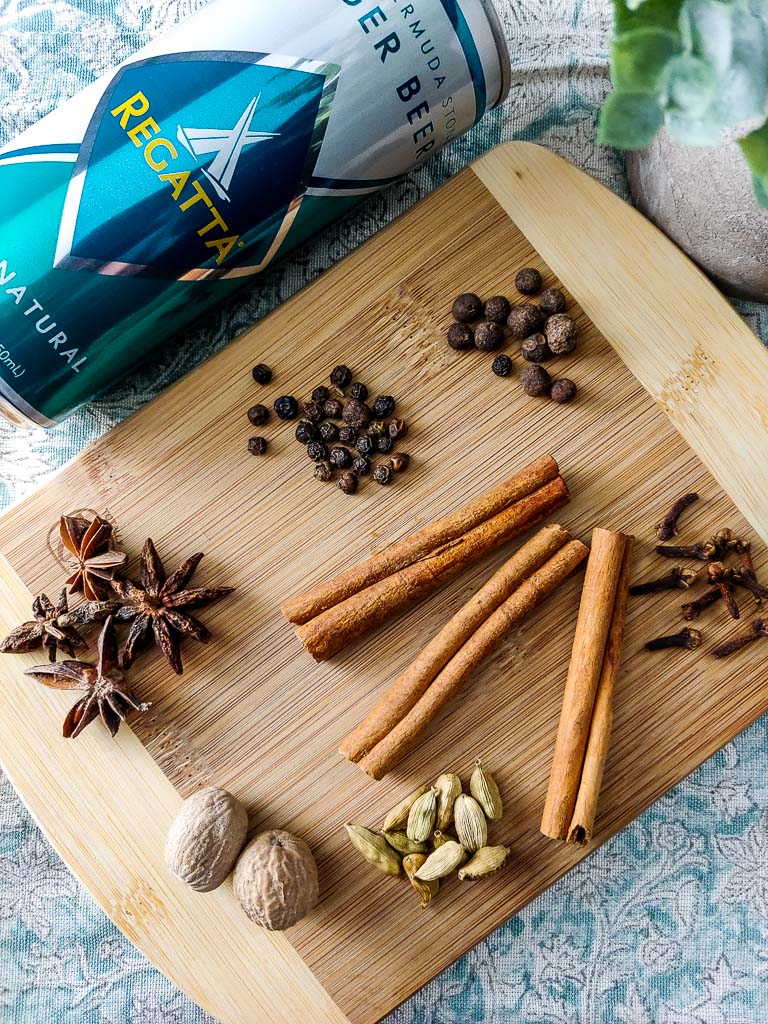
One of the easiest and fastest ways to create unique and creative cocktails is to master the art of the simple syrup. It’s endlessly creative, inexpensive and adds a bevy of flavor and aroma profiles to your cocktails.
Making winter simple syrups is a bit addictive for me. All my favorite spices, an endless combination of amounts and ingredients to play with; it’s my playground.
So when I joked with a craft seltzer maker on social media that I was thinking about reducing their ginger beer as a base for a simple syrup. I didn’t expect the response to be, “Do it! Do it!”
It’s an hour later and my kitchen smells like the warm aromas from the top of a cup of steaming chai. Heaven. So how did I come up with it? It’s not magic, it just takes a little knowledge of simple syrups and how they’re used in cocktails.
(Post may contain affiliate links.)
What is a simple syrup?
A simple syrup is a liquid base with a sweetener added. Generally, for basic simple syrup, you’ll want a ratio of 1:1 of water and sugar by weight. If you’re going for a rich simple syrup, you’re looking at a 1:2 ratio of water to sugar.
The purpose of simple syrup in a cocktail is three-fold
- it adds sugar/sweetness that brightens the other elements of the cocktail
- balances out bitterness or tart citrus flavors, softening them
- increases the mouthfeel or density of the drink, making it taste less thin
All three of these factors must be balanced to put together a great cocktail. Simple syrups can also bind flavors in the cocktail together by the different aromas they have themselves.
For example, if you’re using a cocktail with a rose/juniper gin in a sour, you might choose a rose simple syrup to bring out more of the floral notes or connect it to a related floral element in the drink, like floral bitters. If you’re creating a bubbly cocktail and want to use a dry champagne with a bourbon kick, you might chose a peach or stone fruit simple syrup if those notes jump out at you when you taste the whiskey.
What to Use for the Base of Your Simple Syrup
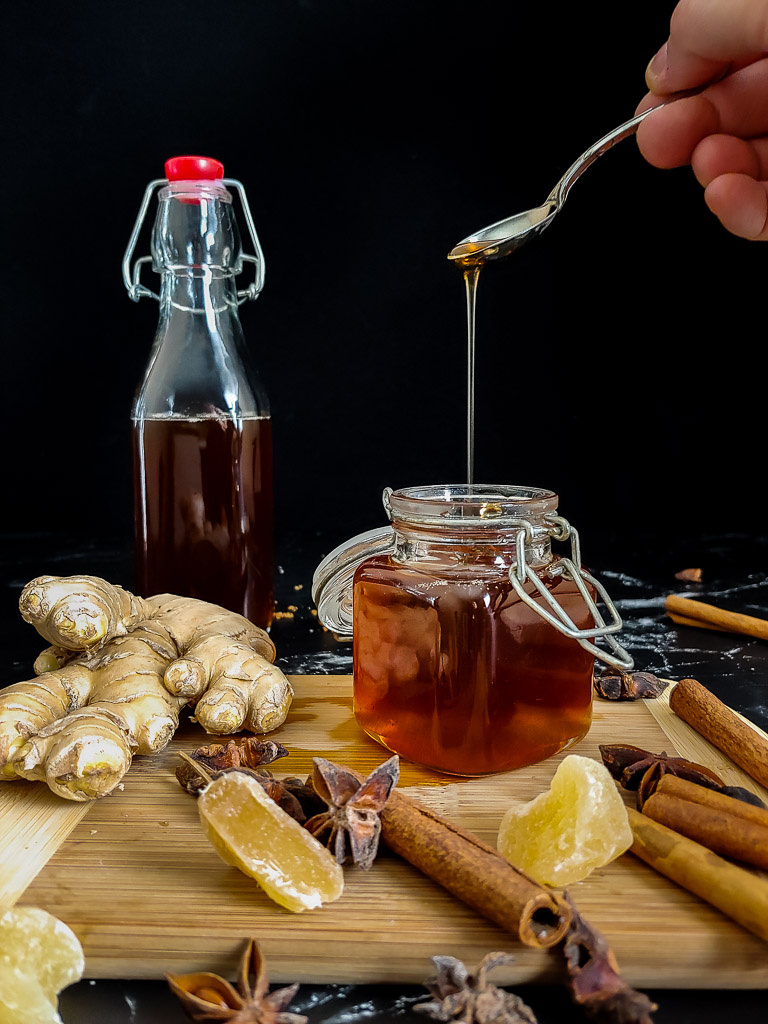
In the vast array of sugars and sweeteners available to us at the grocery, there are hundreds of variations of simple syrups you can put together for your cocktails. In fact, playing with simple syrups is one of the easiest and least expensive ways to up your cocktail skills. All it requires is a little creativity and a look in the pantry to get some interesting results.
The first thing to think about: what you’ll use for the base or liquid or your simple syrup.
Water
The easiest place to start is with water as the liquid base. In that case, varying the types of sugar you use for the sweetener can create vastly different simple syrups. For example, white sugar imparts sweetness with little additional flavor. But, swap out white sugar for demerara or raw sugar and you have a completely different flavor. Other sugars, like brown sugar, coconut sugar, cane sugar, Turbinado sugar, Muscovado sugar have very specific flavor profiles.
Honey/Molasses/Sorghum
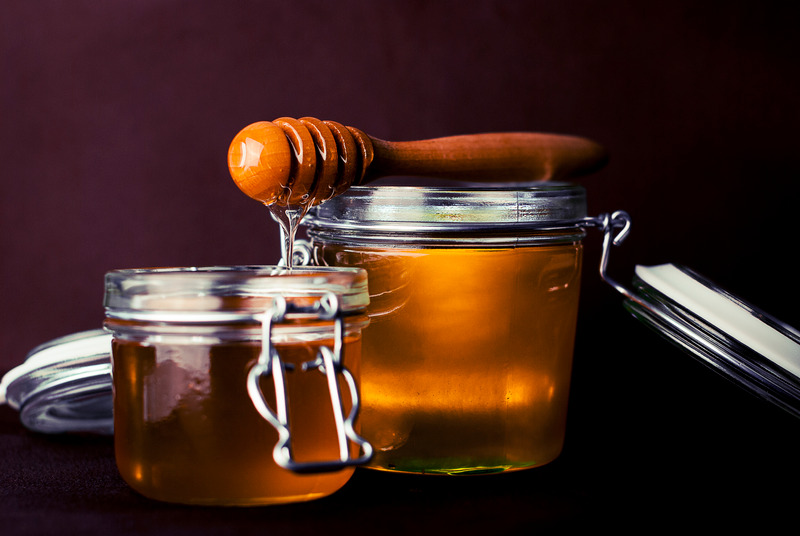
Some simple syrups are made with liquid sweeteners, like honey, molasses or sorghum. All three perform better, in my opinion, when combined with a little water to increase their solubility in cocktails.
While you can add them to a cocktail mixing glass or shaker, because of their composition and how they react to cold, they don’t blend or mix well with the other ingredients. If you’ve ever added honey directly to a cocktail shaker or mixing glass and found most of it remaining in the glass after pouring, you’ll know what I’m talking about.
Because honey solidifies when cold, as does molasses and to a lesser extent sorghum, combining those sweeteners with some warm water to thin them out into a syrup allows them to combine better in cocktails. For honey, molasses, and sorghum, I generally use a 4:1 ratio of sweetener to warm water to dissolve together. Then I store them in the fridge.
Maple syrup, while also a thick consistency, doesn’t have the difficulty blending with cold or iced ingredients, so I don’t tend to add water to it to create a simple syrup.
Teas
One of the easiest and most varied ways to add flavor to your cocktail is to create a simple syrup based on a tea. While you can use a simple breakfast tea, there are thousands of creative tea combinations available now.
Single herbal infusions, such as rose petals, lavender, hibiscus, chamomile, mint, and others allow for a greater degree of control over the exact notes you build into your simple. In those cases, I use one tablespoon of dried herb, such as lavender, rose petals, etc, to a cup of boiling water. Depending on how strong I want the tea, I might let it infuse for just 5 minutes or as long as 30. Then I’ll strain the mixture and add an equivalent weight of sugar to the herbal tea.
Herbal teas, or flavored teas offer a broad range of flavors. I see everything from green tea, berry tea, chai tea, lemon tea, ginger tea, orange spice tea, raspberry tea, cinnamon tea, gingerbread tea, winter spice tea – you name it! If you can find it in a tea shop or on the shelf at your local store, you can turn it into a simple syrup.
My recommendation is to brew the tea at 2 to 4 times the normal strength of the tea. Because we use simple syrups in small amounts – generally less than an ounce in a cocktail – you want to concentrate the tea flavor more than you would for a solid cup of tea. For example, if you usually use a single tea bag for a cup of wild berry tea, use 2 to 4 tea bags. While the tea will be much more potent, again, you use only small amounts.
Note that for floral teas, like lavender and rose, especially, you can easily overdo it. Taste while the tea is brewing to insure you infused the tea to your flavor goal.
Fruit Juices
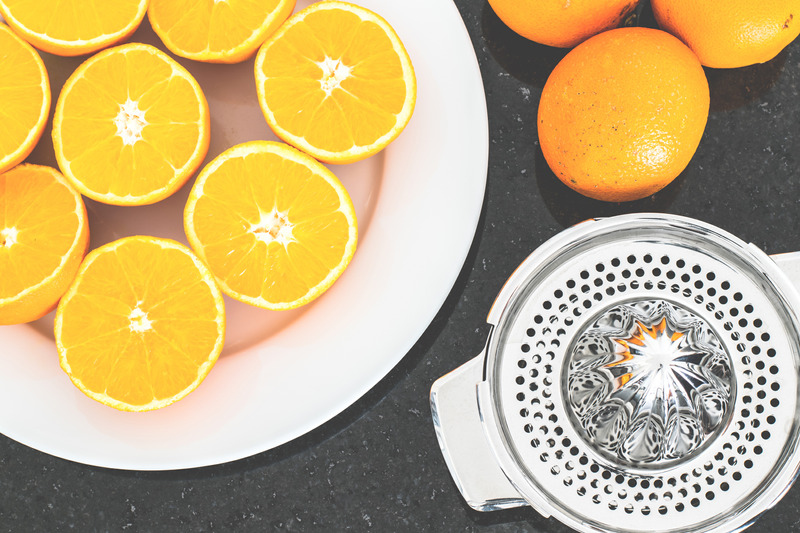
Oranges on a plate with a juicer for simple syrup. By Lum3n.com from Pexels
Simple syrups from fruit juices generally only require one decision – will you be heating the juice or not?
Think about the taste of strawberry jam on a piece of fresh bread. Now think about the taste of sliced strawberries on top of a slice of angel food cake. The two tastes are completely different. Choose the process to use based on which taste you’d like in your syrup: the taste of a fresh fruit or a cooked fruit.
The chemical process of cooking and heating any substance affects flavor and this vastly affects your decision of how to use fruit juices for simple syrups.
If you prefer to use fresh fruit juices, juice them yourself, or buy them fresh and uncooked, and use them as the base for your simple syrup. You will want to strain them and add a sweetener to them, but you’ll need to vary the amount of sugar or sweetener you use based on how sweet the juice is itself and how sweet you want your syrup to be.
I generally add ½ the weight of sugar to the juice initially to mix. Once in the jar, I shake them up and then taste test. I add sugar as needed to get to the sweetness I need.
In some cases, simply adding sugar to fruit draws the juice out of the fruit for you – creating the simple syrup in the fridge or on the counter overnight. I generally use 1 cup of sugar per 2 cups of sliced fruit, then set them in a Ziploc bag in the fridge for 24 to 36 hours. This is my preferred method for strawberries, watermelon, and peaches. Strain once done and store in the fridge.
If you prefer the taste of cooked fruit – the easiest way to create a simple syrup is to combine a small amount of water and the sliced fruit to a small saucepan and add sugar. As the fruit cooks, the juices are drawn out from the fruit and mix with the sugar on the stove. Let the syrup cool, then strain and refrigerate. I prefer cooked fruit with blackberries and pears.
Coffee
We talked about tea, but don’t forget coffee makes an amazing base for a simple syrup. Just taking that leftover cup of coffee, adding a light brown sugar or demerara at 1:1 ratio will make a fabulous coffee syrup. Add a splash of amaretto or hazelnut liqueur and you’ve got a base for amazing espresso martinis, old fashioneds and warm coffee concoctions.
Reduced Sodas and Seltzers
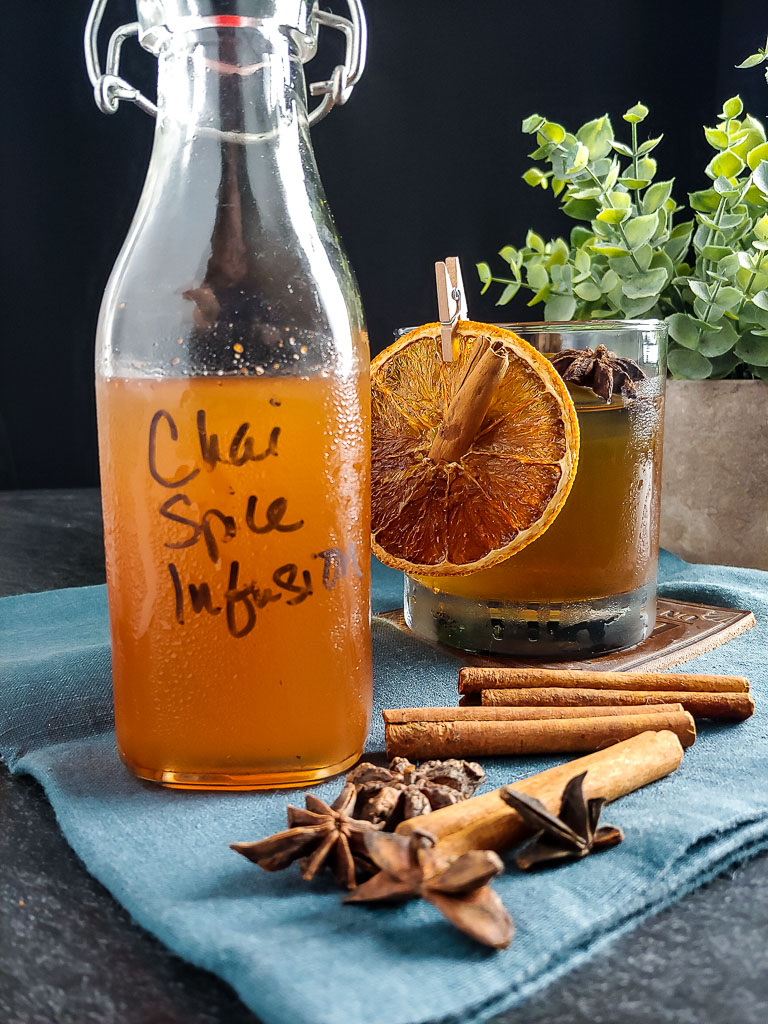
Another option requires a little time at the stove but is well worth the effort. This whole article started out because of a what-if scenario. What if I reduced Regatta Craft Mixers’ Ginger Beer to make a simple syrup? I’ll put the recipe below, but in essence I reduced two cans of the ginger beer down by half, and added chai spices to the reduction as it was simmering.
Reducing concentrates the flavors of the base liquid and can likewise concentrate the sweetness. In this case, the ginger beer was much sweeter when reduced, but still tasted thin. I added sugar to the strained reduction to add more sweetness and to increase the coating mouthfeel of the syrup.
I’ve reduced colas, root beer, flavored seltzers and ginger beer. Of those experiments, the ginger beer reduction and the root beer reduction were the most successful. Note that you’ll need to watch the sodas as they heat, because they’re carbonated they easily spill over as the heat pushes the gasses out of solution all at once.
For the reductions I generally reduce by ½ to ¾ depending on the flavor concentration and sweetness I am targeting. Reducing on the stove is as simple as letting a liquid simmer under low heat until the volume has reduced and the desired taste is achieved. Stirring every 5 to 10 minutes keeps the pot from boiling over or burning, and lets you taste test during the reduction process.
Reduced Wines and Beers
Have some extra wine or beer you’re not going to be able to finish? Again, it’s a simple matter to reduce it over low heat to concentrate the flavors and add some sugar. You’ll use the same process as with the seltzers and sodas above.
One of the best simple syrups I’ve ever made was a reduction of a porter beer and an equal amount of sugar until the combination was reduced by half. It became a chocolately, coffee-flavored maple-tasting syrup that was a delight in old fashioneds and winter cocktails.
Port wine, as sweet as it is, doesn’t need much sugar added. I would wait until the wine is reduced by half, then add sugar in ¼ cup amounts until you’ve got a level of sweetness that suits you.
Do note that reducing either beer or wine will make your entire house smell like a beer hall or bar. Try and do it sometime when you can open the windows to air out the house afterwards. Unless that kind of scent appeals to you. Blegh.
Adding Infused Elements
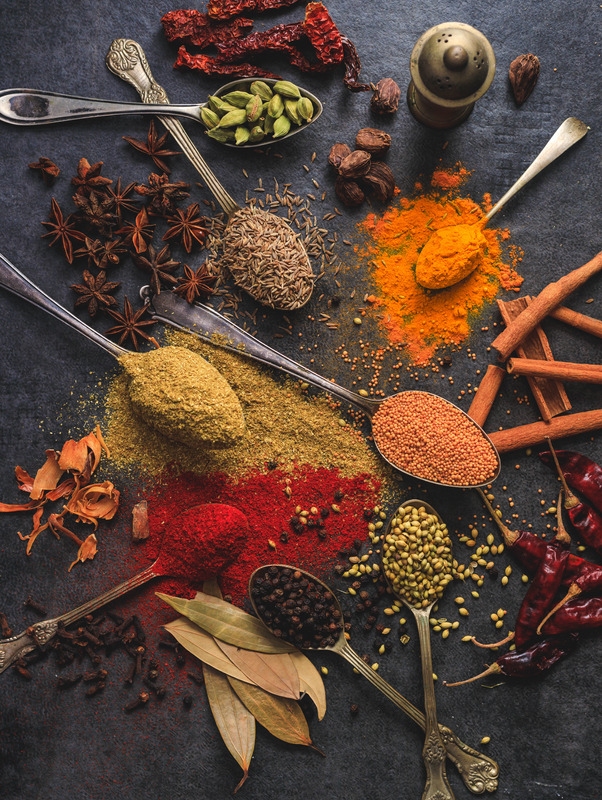
Adding variables to the mix like spices and herbs as an infusion allows layers of flavor to build on one another. For example, with my chai-infused ginger beer reduction, I used a spice combination used for chai tea – peppercorn, cinnamon, cardamom, allspice, nutmeg and ginger.
Infusing with Spices
When using spices for infusions, because they are dried, you can often use less of them, since their flavor is concentrated, and you can put them under a higher heat. Because they’ve already been dried, they’re not as fragile in their scents as fresh herbs. I often let them steep in the liquid while it is reducing, or add toward the end and let it steep while the syrup completely cools to room temperature.
Infusing with Fresh Herbs
If you’re using fresh herbs to infuse, you can add them to the mixture while still warm (but not under heat), and let them infuse until the concoction completely cools. Or, you can add them to the mixture as you put it in the fridge and let it steep for a longer period of time.
Right now I have three jars of simple syrup in the fridge infusing with the last of the fresh basil from the garden. One is just basil, the other is basil and blackberries and the other is basil and cherries. I have high hopes for all three. It’s been 48 hours, and they have a gorgeous basil/licorice flavor and aroma I can’t get enough of.
Simple Syrup Variations for Cocktails
I’ve put together a quick list of some variations of simple syrups I’ve made that I come back to time and again. Treat this as a place to start or kickstart your own creative simple syrup juices.
- Rosemary Peach (cooked)
- Peach Cinnamon (uncooked)
- Strawberry Basil
- Cinnamon Star Anise (licorice)
- Coffee Cinnamon
- Porter beer – vanilla bean
- Blackberry Basil (cooked)
- Apple Cider
- Pineapple Sage
- Mango Toasted Pecan
- Rose Honey
- Lavender Honey
- Watermelon
- Watermelon Mint
- Root Beer Syrup – reduced to ¼
- Fennel Fig
- Rhubarb Peppercorn
- Strawberry Champagne
What to Do with Simple Syrup?
You mean, besides cocktails? Simple syrups have many culinary uses:
- Syrups for pancakes, waffles, ice cream or desserts.
- Flavored lemonades or teas (they are fabulous in teas).
- Use it to candy fruits – especially citrus
- Add to smoothies or milkshakes
- Add to warm teas or coffee
As to cocktails you’ve got plenty of classics to play with:
- Old Fashioned
- Daquiri
- Margarita
- Mojito
- Whiskey Sour
- Smash
- Gin Sour
- Champagne/Bubbles Cocktails
- Cobblers
- Frappes – Hibiscus Absinthe Frappe
Conclusion – Making Simple Syrup
Like most things having to do with cocktails, it’s a journey of discovery of your own taste and flavor preferences, as well as how you’ll want to use the syrups. For now, I’ll leave you to this recipe of the inspiration of this post – a Chai spice-infused simple.
Recommended Bar Tools
You don’t need every slick, beautiful bar tool out there, but there are several I’ll recommend. (As an Amazon Associate I earn from qualifying purchases. However, that does not affect the cost of the items below.) My favorite pieces usually come from the Cocktail Kingdom section of Amazon:
You may already have these bar essentials, but just in case:
Other Fall Cocktails You Might Enjoy
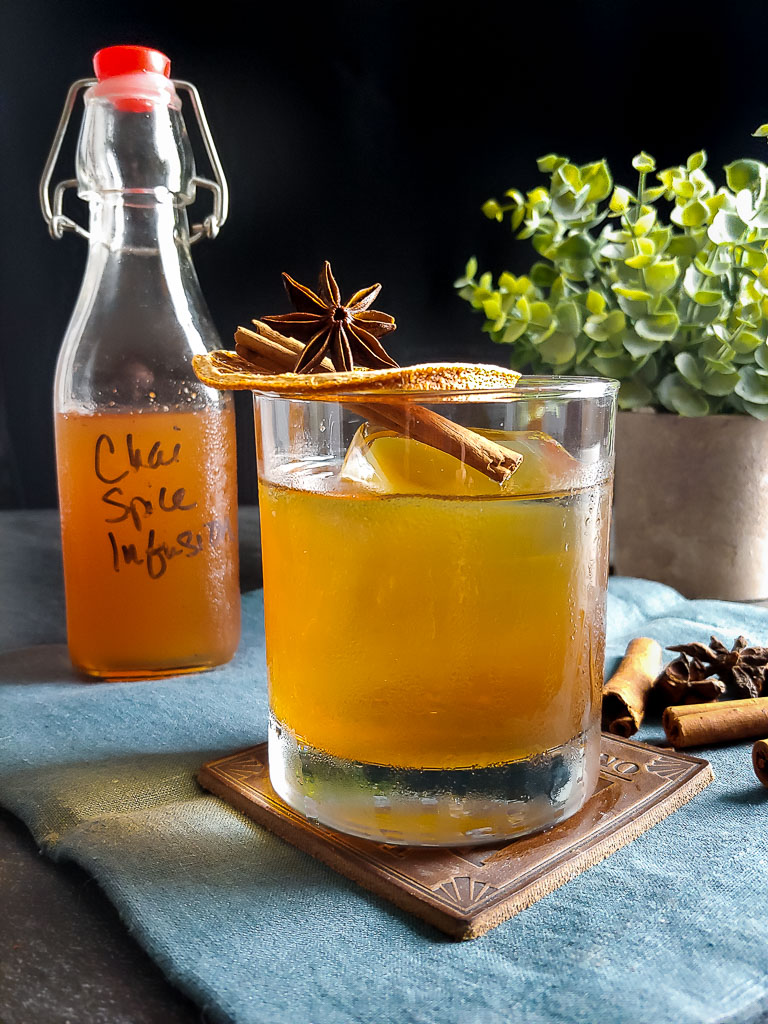

Chai Spice Infused Simple
Ingredients
- 2 cans of ginger beer – 8 oz each
- 4 cinnamon sticks cracked
- 1 nutmeg crushed/cut into 3 or 4 pieces
- 3 cloves
- 4 peppercorns
- 6 whole cardamom pods lightly bruised
- 4 allspice
- 2 star anise
- ½ cup sugar
Instructions
- Add the ginger beer and spices to a small sauce pan and set to a low boil (watch to make sure it doesn’t boil over due to the carbonation in the soda). Let reduce to ½ – about 45 mins, stirring occasionally. Add ½ cup of sugar, mix and let cook completely. Strain and pour into a clean jar. Store in the fridge.
This is soooooo yummy! I want to eat it with a spoon, which would be really bad! The only spice I didn’t have on hand was star anise but it is amazing without.